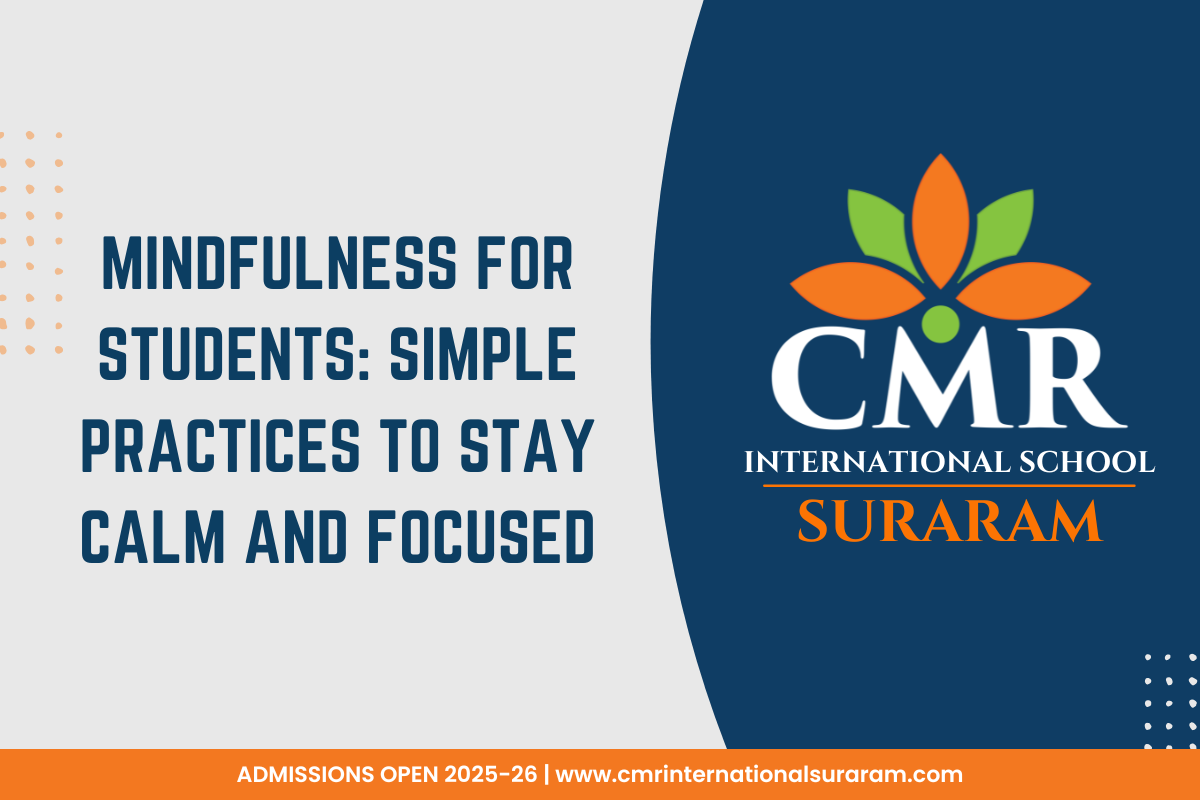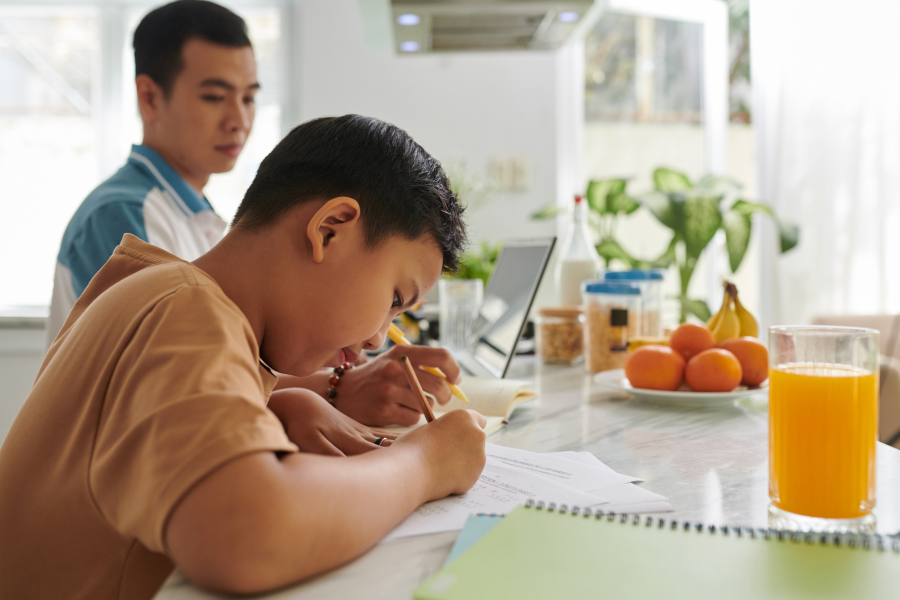Introduction
Have you ever noticed how hard it is to focus when your mind is buzzing with a thousand thoughts? From exams and assignments to social media and friendships, students today face more distractions and stress than ever before.
That’s where mindfulness comes in.
At CMR International School, Suraram (CMRIS), we integrate mindfulness into everyday student life to help our learners stay centered, focused, and emotionally balanced. And the best part? You don’t need fancy equipment or long hours—just a few minutes a day can make a huge difference.
Table of Contents
| Sr# | Headings |
|---|---|
| 1 | What is Mindfulness and Why Does It Matter? |
| 2 | Benefits of Mindfulness for Students |
| 3 | How CMRIS Incorporates Mindfulness into School Life |
| 4 | Deep Breathing: The First Step to Focus |
| 5 | Mindful Listening Activities |
| 6 | Gratitude Journaling for a Positive Mindset |
| 7 | The 5-4-3-2-1 Grounding Technique |
| 8 | Mindful Walking and Body Awareness |
| 9 | Using Visualization to Reduce Anxiety |
| 10 | Managing Exam Stress with Mindfulness |
| 11 | Screen-Time Breaks and Digital Mindfulness |
| 12 | Practicing Mindfulness in the Classroom |
| 13 | Encouraging Mindful Friendships and Kindness |
| 14 | Daily Mindfulness Routines for Home and School |
| 15 | Long-Term Impact of Mindfulness on Student Success |
1. What is Mindfulness and Why Does It Matter?
Mindfulness means paying full attention to the present moment—without judgment. It’s about being aware of your thoughts, feelings, body, and surroundings instead of reacting on autopilot.
When students are mindful, they are less stressed and more focused—which leads to better learning and emotional control.
2. Benefits of Mindfulness for Students
Practicing mindfulness daily can help students:
- Improve focus and memory
- Reduce anxiety and stress
- Sleep better
- Become more empathetic and patient
- Make better decisions
- Stay calm during exams and public speaking
At CMRIS, we’ve seen students become more self-aware, confident, and emotionally strong through regular mindfulness activities.
3. How CMRIS Incorporates Mindfulness into School Life
From morning meditations and reflective journaling to silent breathing before tests, mindfulness is a part of our daily rhythm. Our teachers are trained to lead students in short guided practices, making mindfulness a habit, not a task.
4. Deep Breathing: The First Step to Focus
One of the simplest and most powerful mindfulness tools is deep breathing.
Try this:
- Inhale slowly for 4 seconds
- Hold for 2 seconds
- Exhale slowly for 4 seconds
Repeat this for just 2 minutes before studying or starting the day. It relaxes the body and clears the mind.
5. Mindful Listening Activities
Close your eyes and listen—really listen. Can you hear a fan? Birds? Your breath?
Mindful listening trains students to focus on one sense at a time, helping improve attention and reducing the mental noise that can distract them.
6. Gratitude Journaling for a Positive Mindset
Each day, write down three things you’re grateful for. It can be as simple as “I enjoyed lunch with a friend” or “The sky looked beautiful.”
Gratitude helps shift focus from complaints to appreciation, building a happier, healthier mindset.
7. The 5-4-3-2-1 Grounding Technique
This quick tool helps students manage anxiety:
- 5 things you can see
- 4 things you can touch
- 3 things you can hear
- 2 things you can smell
- 1 thing you can taste
Use it during stressful moments to return to the present and feel more grounded.
8. Mindful Walking and Body Awareness
Take a slow, silent walk—focus on how your feet touch the ground, how your body moves, and how the air feels.
Mindful walking isn’t just calming—it builds body awareness, helping students tune into signs of stress, fatigue, or excitement.
9. Using Visualization to Reduce Anxiety
Close your eyes and imagine a peaceful place—a beach, a garden, or a mountain top.
This technique helps students feel safe, focused, and relaxed before tests, competitions, or public speaking.
10. Managing Exam Stress with Mindfulness
Before a big test, students can:
- Do a quick breathing exercise
- Close their eyes and say positive affirmations like “I am prepared” or “I will do my best”
- Focus on one question at a time
Mindfulness gives students tools to calm nerves and stay present under pressure.
11. Screen-Time Breaks and Digital Mindfulness
Teach students to pause and reflect before using a screen:
- Why am I opening this app?
- How long will I use it?
- How do I feel after using it?
Encouraging these checks builds digital discipline, reducing mindless scrolling and improving attention spans.
12. Practicing Mindfulness in the Classroom
Teachers can:
- Start lessons with a 1-minute silence
- Pause during long lectures to let students breathe and reflect
- Encourage mindful transitions between subjects
These tiny pauses refresh the brain and improve focus.
13. Encouraging Mindful Friendships and Kindness
Mindfulness isn’t just internal—it’s social.
- Teach students to listen fully when a friend is talking
- Encourage kind acts and reflection on their impact
- Practice empathy through stories and discussions
Mindful friendships help students become kinder, more compassionate individuals.
14. Daily Mindfulness Routines for Home and School
A simple daily routine may include:
- Morning breathing practice
- Silent reflection before lunch
- Gratitude journaling before bedtime
When mindfulness is part of a child’s routine, it becomes a natural response to life’s challenges.
15. Long-Term Impact of Mindfulness on Student Success
Mindful students grow into:
- Calm exam-takers
- Better listeners
- More focused learners
- Resilient individuals
At CMRIS, we’re proud to nurture not just smart students, but balanced, emotionally aware individuals who thrive in every aspect of life.
Conclusion
Mindfulness isn’t magic—but it sure feels like it when you see a student breathe deeply before a test, reflect calmly after a mistake, or offer kindness when a friend is upset.
At CMR International School, Suraram, we’re committed to teaching life skills that go beyond the classroom. With just a few minutes of mindfulness each day, students learn to face life with clarity, calm, and confidence.
FAQs
1. What age is best to start mindfulness?
Children as young as 4 or 5 can begin simple mindfulness activities like breathing and noticing sensations.
2. Do students really benefit from mindfulness?
Yes! Research and experience show that mindful students have better focus, reduced stress, and improved emotional regulation.
3. How often should students practice mindfulness?
Even 5–10 minutes a day can make a difference. Consistency is more important than duration.
4. Can mindfulness help with exam stress?
Absolutely! It helps students stay calm, clear-headed, and confident under pressure.
5. Does CMRIS offer mindfulness programs?
Yes, CMRIS integrates mindfulness into daily routines, assemblies, and classroom practices across all grades.



